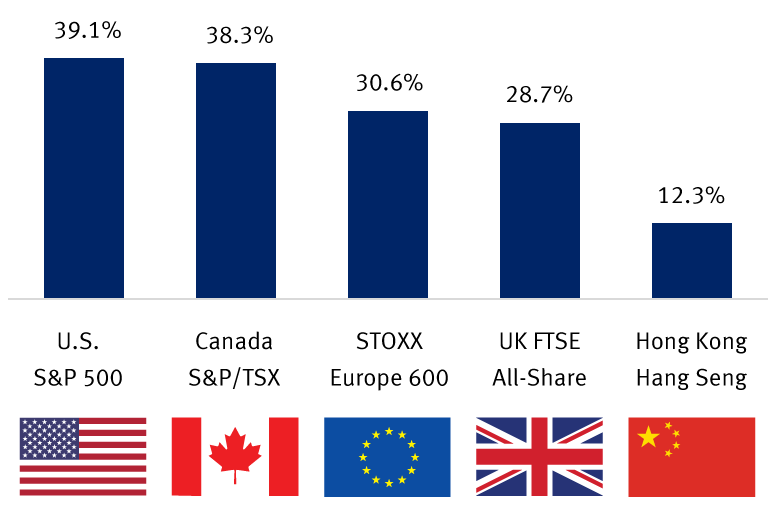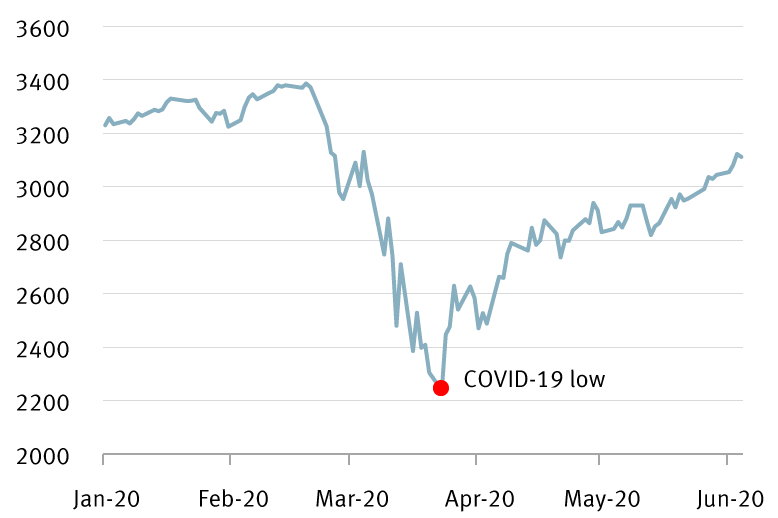Normally, equity markets face a wall of worry—and lately, there has been a mountain of worry. Yet following the initial steep COVID-19 selloff, markets have climbed the mountain successfully. U.S. and Canadian indexes are up almost 40 percent since the March lows, and major European markets are up about 30 percent.
Big rallies off the low despite a mountain of bad news
Equity index performance since the MSCI World and S&P 500 bottomed on Mar. 23, 2020

Source - RBC Wealth Management, Bloomberg; data through 6/4/20
With equity markets so buoyant during the economic crisis induced by COVID-19 lockdowns, and even drifting higher as the racial justice crisis has re-emerged, why does America’s Main Street seem so disconnected from Wall Street?
Investor optimism, policy pragmatism
Of course, there are practical reasons why equity markets are moving at a faster pace:
- Markets look forward, not backward, and they’re concluding that the current economic challenges will be temporary.
- The U.S. market seems to be assuming that the domestic economy and corporate profits will be back to 2019 levels sometime next year (we think it will be a little later).
- The Federal Reserve has thrown more than the kitchen sink at the severe economic crisis, backstopping the credit market for the first time in history. In hindsight, this has been a boon for the stock market and has supported valuations.
- Fiscal stimulus has also helped boost the market, in our view.
But this still begs the question, why aren’t difficulties on Main Street reflected on Wall Street during this period of severe economic and social distress?
Multinationals (often) move markets more
In reality, Wall Street and Main Street don’t always move at the same pace, especially when major non-market-related events occur. This has been the case throughout history. The profit trends and future prospects of companies within “the market” can diverge at times from wider problems in society, especially during unique challenges such as pandemic lockdowns, social justice struggles, or crises in government.
They can even diverge when segments of the economy come apart. One example is the savings and loan (S&L) crisis, which began in the 1980s and stretched into the 1990s. It took down more than 1,000 of these small financial institutions, or roughly one-third of the total, across the country. The crisis contributed to the 1990 recession and hit the U.S. equity market at that time (and some would argue that its nascent phase contributed to the 1987 bear market), but the S&P 500 began a sharp recovery rally in 1991. However, the S&L crisis had a much longer aftermath in the communities where many of these institutions were located, and continued to impact local small businesses for years.
Furthermore, “the market” is actually a narrower slice of private enterprise than it is often perceived to be. When the business press refers to “the market,” it is normally referring to the S&P 500, which represents roughly 500 large-cap (and mega-large-cap) companies at any given time, many of which are multinationals. This index includes big companies like Microsoft, Citigroup, Walmart, Honeywell, Chevron, etc. This isn’t Main Street.
Another prominent large-cap index, the Dow Jones Industrial Average—which still has the reputation of being “the market” among a lot of North American investors—is even narrower: only 30 companies, including most of those household names listed above.
Both of these large-cap indexes attempt to reflect the broad composition of the U.S. economy, but they certainly don’t capture the nuances of small and medium-sized business activity in cities and towns across North America.
Furthermore, while representation of mid- and small-cap companies is an important component of equity investing, the main U.S. indexes aren’t very representative of the American small business community—and they are not designed to be. True, these indexes are a significant step below large caps in terms of the market value of the companies represented, so they are indeed much “smaller,” but their constituents are in fact much larger than the small mom-and-pop businesses that are all over the country.
The road ahead to economic recovery
Even during economic expansion cycles, gaps can open up between Wall Street and Main Street.
S&P 500 gains can far outpace GDP growth. In seven of the 10 economic expansion cycles since 1949, the S&P 500 price return exceeded the expansion in nominal GDP, according to Bloomberg Intelligence. In four of those cases, the market overshot GDP by wide margins.
And while the S&P 500 and GDP tend to move together directionally over the longer term—rising, falling, or treading water—they can diverge in the shorter term.
Ahead of itself?
S&P 500 Index year to date

Source - RBC Wealth Management, Bloomberg; data through 6/4/20
Thus far, the stock prices of most publicly traded companies have been able to shake off the negative impacts of the COVID-19 lockdowns, with the exception of some at the epicenter of the lockdown recession, due to optimism about the prospects for economic and earnings recoveries. But mom-and-pop small businesses are just beginning to get back on their feet, and some have been knocked right back down due to widespread social unrest.
RBC Capital Markets, LLC Chief U.S. Economist Tom Porcelli believes the road ahead for the economy overall will be a slow one, and there could still be some pain ahead of us, as he stated in this recent audio commentary. It could very well be that Wall Street has gotten ahead of itself. That is certainly the view of RBC Capital Markets, LLC Head of U.S. Equity Strategy Lori Calvasina. These are among the reasons we still think it’s prudent to have some dry powder in equity portfolios.
Non-U.S. Analyst Disclosure: Jim Allworth, an employee of RBC Wealth Management USA’s foreign affiliate RBC Dominion Securities Inc. contributed to the preparation of this publication. This individual is not registered with or qualified as a research analyst with the U.S. Financial Industry Regulatory Authority (“FINRA”) and, since he is not an associated person of RBC Wealth Management, may not be subject to FINRA Rule 2241 governing communications with subject companies, the making of public appearances, and the trading of securities in accounts held by research analysts.
In Quebec, financial planning services are provided by RBC Wealth Management Financial Services Inc. which is licensed as a financial services firm in that province. In the rest of Canada, financial planning services are available through RBC Dominion Securities Inc.
